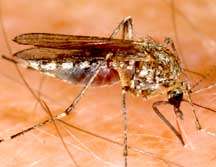Heat extends mosquito season, West Nile threat in Montana

Hot weather has extended Montana's mosquito season into September, and that means West Nile virus is still a threat, says Montana State University entomologist Greg Johnson.
Urging Montanans to wear repellents, Johnson said mosquitoes normally stop biting when temperatures fall below 50 degrees during the night, but that hasn't happened in most of Montana yet.
"We are just not seeing that now," he said. "And when temperatures are up to 95 and 100 degrees during the day, these are conditions that are still good for mosquitoes."
Johnson, in his fourth season studying the West Nile virus, has found that the Culex tarsalis mosquito is the primary carrier in Montana. The mosquito usually starts flying shortly after sundown and continues until 1 or 2 a.m.
By the end of August, Johnson said he had seen a fair number of infected mosquitoes in Eastern Montana, specifically in Blaine, Dawson, Phillips, Prairie, Sheridan and Sweet Grass counties. Traps in all but Sheridan County were located along the Milk or Yellowstone rivers. Johnson didn't find any infected mosquitoes in Western Montana until late August, but said one person and two horses in Flathead County were infected this summer. Infected mosquitoes -- the first found in Western Montana -- appeared in Darby.
The Milk River at Malta yielded the highest rate of infected mosquitoes this year, Johnson said. Four out of every 1,000 captured mosquitoes carried West Nile virus, a rate so high that Johnson said it warranted concern for public health.
Johnson recommended repellents for humans and spring vaccinations for horses.
"Repellents containing DEET or picaridin are most effective," he said. "Several different trade names are available that contain various concentrations of DEET. A repellent containing 20 to 30 percent DEET is adequate. Cutter Advanced has picaridin as the active ingredient."
None of the infected horses were vaccinated, but vaccinations would likely have kept them from getting West Nile virus, Johnson said. Too late for this year, vaccinations must be given in the spring, he added. Vaccinations involve two immunizations given three weeks apart. Horses are fully immune three weeks after the second shot.
Todd Damrow, state epidemiologist, said he encourages a variety of preventative measures for people. He recommends repellents, avoiding times and places of heavy mosquito activity and covering exposed skin. "Roll sleeves down instead of up," Damrow said. He advises people to reduce mosquito habitat by emptying water out of pails and old tires, for example, and changing the water in bird baths every day. Some communities set up mosquito control districts and spray for mosquitoes.
Montanans shouldn't become complacent even if they live in a county where Johnson hasn't found infected mosquitoes, Damrow warned.
"People across the state should be aware of the potential," he said. He added that West Nile virus is an exotic African virus that was introduced into the United States in 1999. Now that it's here, Damrow said, "The genie is out of the bottle."
Johnson trapped mosquitoes in 33 Montana counties this summer and expects to continue at least through mid-September. Eleven of those counties were west of the Continental Divide and 22 were east. Johnson said he captured mosquitoes in six state parks and wildlife management areas, too, since many of those have wetlands where mosquitoes thrive and water fowls migrate.
Source: Montana State University




















